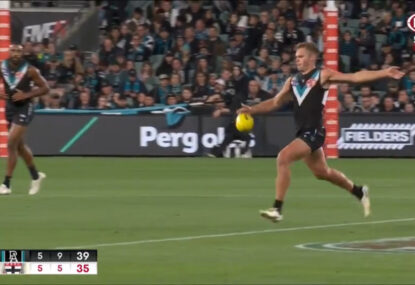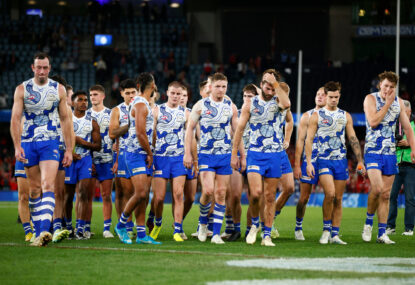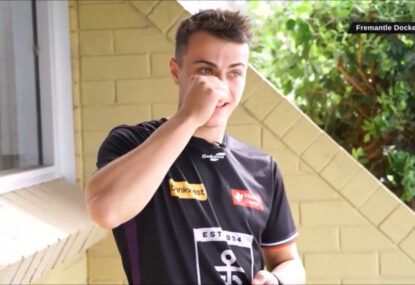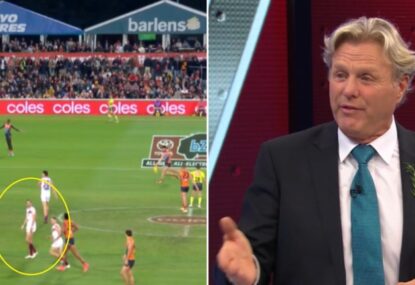Our popular spectator sport Aussie rules has been bombarded with unfavourable stories recently, such as revelations regarding Fremantle’s Ryan Crowley.
Crowley’s positive drug tests from July 2014 was the first indication that the issues facing Australia’s AFL community was only just the beginning. With the Essendon saga nearing an end, we now find the tabloids also full of stories about a Fremantle player on a provisional suspension waiting for his tribunal hearing.
We also have former West Coast captain and champion Ben Cousins facing criminal charges for evading police and a former Hawks and Richmond player Billy Nicholls being sentenced to 11 years for shooting two men.
As if this wasn’t enough, former Carlton and Port Adelaide player Nick Stevens has been found guilty of 12 charges relating to threats and assault inflicted on his ex-partner in 2012 and 2013. To add insult to our already injured landscape, reports have surfaced that suggest that an exceptionally dangerous and highly addictive methamphetamine known as ice has been given to grassroots footballers as young as 14.
Crowley is an interesting case in isolation as he was able to continue competing even into the 2014 finals series despite the positive test results. Crowley took the substance via a painkiller he sourced outside the club and seemingly without the club doctor’s knowledge.
Crowley began his provisional suspension in September after the Dockers exited the finals with a semi-final loss to Port Adelaide and now awaits the tribunal hearing, set to begin in May after significant delays from the AFL in issuing the show cause notice.
A timeline given by the AFL shows a delay of 29 days between receiving the A sample on July 13, to when it was tested and a further 31 days to the B sample. This resulted in Crowley receiving his show cause notice from ASADA on September 18 and a two-week wait for the infraction notice from the AFL.
The AFL has not given much clarity on the happenings of the last six months since the infraction notice. It is thought that the ADRV panel is at its capacity with the Essendon hearings, which will cause Crowley to miss the start of the 2015 season.
Cousins has continued his horror run with authorities after extending his rap sheet further with several arrests, all suspected to be drug related. Recently Cousins was intercepted by police after leading them on a low speed chase. Cousins refused to undergo alcohol and drug testing.
Since being released on bail, Cousins was again arrested after breaching security at an SAS base and shortly after, again for driving erratically outside a Sikh temple then climbing onto the roof of a two-story home. Cousins was talked off the roof by police in front of horrified witnesses, one of which described Cousins as “not looking stable”.
Cousins has now been admitted to a mental hospital awaiting an assessment. It is still not fully confirmed if any drugs were involved, however Cousins does have a history of substance abuse throughout his career, being dropped from the West Coast Eagles and suspended from the AFL before making a successful return to AFL at Richmond.
Nicholls has received a sentence of 11 years for shooting Khalib Alloush and Scott Shepherd in the legs in separate incidents, both which occurred in Geelong during 2012 and 2013. Both victims recovered after surgery. During Nicholls’ hearing, the court heard that he had turned to the methamphetamine ice after being delisted.
The incidents both revolved around drugs and drug money, with medical assessments taken at the time of the incidents showing that Nicholls was suffering from a substance-induced psychotic disorder. Nicholls has since been sentenced to 11 years jail, with an eight-year parole free period for the incidents.
Former Carlton and Port Adelaide star Nick Stevens has been found guilty of 12 charges of violence and threats towards his ex-partner. The charges included five counts of assault, four threats to kill or inflict injury, two of intentionally causing injury and one count of property damage.
Stevens was subsequently sacked from the South Australian National Football League club, Glenelg, where Stevens was coach. Glenelg issued a statement announcing the termination of Stevens’ contract and wishing him “all the best in working through the challenges he has ahead”. Nick has since been granted bail while he lodges an appeal to his eight-month jail sentence.
Ice has also surfaced as a problem in grassroots and suburban football as a performance enhancing drug. The National Drugs campaign lists some of the effects of ice as being a ‘rush’, providing a feeling of exhilaration and increased arousal and activity levels.
The long-term effects of ice are quite serious and include an increased risk of stroke, decreased lung function, poor cognitive function and short-term use can result in high blood pressure and subsequent heart problems. What is most disturbing about these reports is that the reports suggest the users are as young as 14 years old, with Lindenow Football Club officially stating that this was an issue for all clubs.
VAFA Point Cook Football Club Director of Football Dan Lennon rejects the notion that the use of ice is rife in suburban football stating: “local football in its entirety is generally a safe haven from the rubbish flooding streets. Coaches and officials supplying ice to players [is] rampant among leagues is a gross overstatement, and nonfactual”.
What is clear is that the AFL sporting community has taken a public beating over the last few years. It would be an understatement to suggest that the fans are tired of the negative stories – and they have every right to be.
However, it is important to always put perspective into any thought. For example, how many footballers turn up for their games and training sessions every week who have not committed any crime, listed above or not? Surely this number dwarfs the number of footballers who have.
Conversely, how many people are charged with crimes, appear in court or are convicted every day? It is a list which will be relatively scant of recognisable names. When those are considered, we can see that our sporting landscape is not all doom and gloom and for the most part, still a positive, family friendly environment to participate in.
AFL is for many a chance to experience acts of heroism and the very essence of our nation’s values. Indiscretions that sully our great game are naturally unwanted but more importantly, often avoidable. We can all hope for a clean sport one day and given the issues surfacing, first impressions would suggest this may be some time off.
However, every weekend the siren will sound and all of our favourite athletes, who come from any background to play, will compete for the big prize.
As long as this continues, the sport is doing something right. Given the relatively small number of player issues when compared to the wider football community, a clean sport may not be an unachievable dream.


































































































